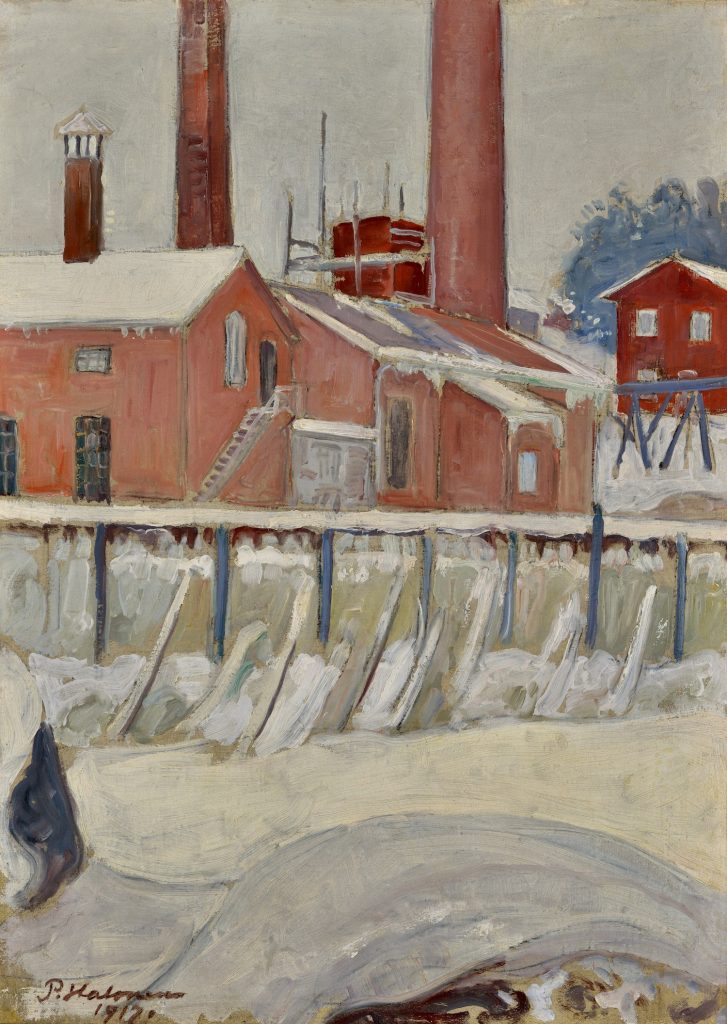Factory landscape from Ladoga Karelia,1917
This year marks the 150th anniversary since the birth of artist Professor Pekka Halonen (1865–1933) who is known for his depictions of forest interpretations of Finnish winter landscape. In winter 1917, he painted two winter landscapes at Leppäkoski mills (Leppäkoski Fabrikers Aktiebolag) in Karelia on Lake Ladoga. Both oil paintings belong nowadays to Gösta Serlachius Fine Arts Foundation’s collections.
Mill owner Gösta Serlachius from Mänttä acted as the chair of the board 1913–1918. Posterity has no knowledge of whether Serlachius commissioned the artworks directly from the artist himself or whether they came from another source. The artworks depict a view of a snowy factory site. Subsequeantly, you can see its chimneystack and buildings made of bricks or painted with red ochre paint. The artist has outlined one of the paintings so that behind the snow stack standing on the foreground, one can see a dammed rapid. Through the rapid the water from Jänisjärvi flows toward Lake Ladoga.
Leppäkoski was located in the rural municipality of Sortavala, subsequently called Harlu municipality since 1922. It was in the middle reach of River Jänisjoki, north of the industrial centre of Läskelä. Läskelä lied a little closer to the Lake Ladoga shore. A power plant, a saw mill as wells as paper and brick factories constitute the factory complex. The area was familiar to Pekka Halonen. His wife Maija (formerly Mäkinen) was born in Myllykylä, a quite a small village of the rural municipality of Sortavala. The distance between Myllykylä and Leppäkoski was by road about 35 kilometres.
The artist completed the paintings one year before Serlachius gave up his position as the chairman of the board of Leppäkoski mills in 1918. Paper industry suffered of recession after Finland became independent. As a result, Serlachius sold his shares of Leppäkoski in 1924. Four years after this he stated that businesswise Leppäkoski had been the biggest act of stupidity he had taken in his life.
Serlachius presumably commissioned Halonen to paint the artworks. To paint the snowy old pine trees of Karelia must have been closer to his heart than painting the industrial production plants. The forest was an unending treasury of motifs for Halonen. Serlachius, on the contrary, saw it as a stock of raw material. However, he could also enjoy spending his free time there hunting or fishing.
Beside Leppäkoski, Gösta Serlachius has another point of reference in Karelia. In 1915 he has acquired several forestry holdings at Suistamo and Impilahti. In 1916 they constituted the over 6000-hectare-wide Syskyjärven Hovi Oy. Serlachius owned the forestry holding until the spring 1928.
Finnish artists had made pilgrimages to different parts of Karelia since the first part of 1890s. Similarly, Serlachius invited artists to Syskyjärvi to work and ”to be hosted in an genuinely Karelian environment”. Also Pekka Halonen was invited there just before Syskyjärvi was sold. Presumably he never made the trip to Syskyjärvi before Serlachius sold it.
In late 1927, Serlachius had delivered a batch of paper. After receiving the delivery the artist had suggested an exchange. As a result, Halonen would trade one artwork depicting possibly Syskyjärvi to a second batch of paper. In exchange for paper sheets Serlachius would receive, according to Halonen, ”a canvas slightly smeared with colour”.
Marjo-Riitta Simpanen
Curator, art historian


